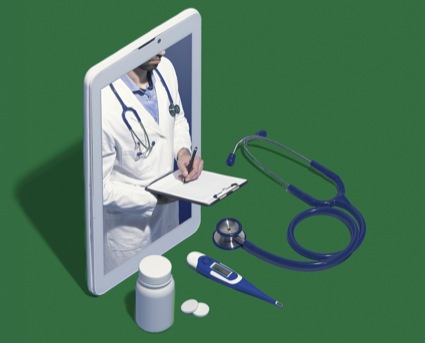With the COVID-19 crisis, practices can stay “open” through remote communication. With that in mind, here are a few FAQs about reimbursable services.

Glenn Littenberg, MD, is a coding advisor for the American Society for Gastrointestinal Endoscopy and the chair of the society’s reimbursement committee. Dr. Littenberg is the chief medical officer of inSite Digestive Health Care in California and managing partner of its Gastroenterology Associates branch in Pasadena, Calif.
Q. Does telehealth need video as well as audio?
A. Yes, although other options exist (see below), A/V is required under the definition of telehealth. Clinicians can now bill for real-time visits of many types. Here’s a brief recap of the latest rules from Medicare (see Interim Rule, March 31, 2020):
- For a substitute for an office visit, use office visit codes (99201-99205, 99212-99215) and office place of service 11, with 95 modifier (telehealth) on the claim, no matter where you are doing the service and no matter where patient is.
- You can document these as needed, without regard to extent of history or exam, based on either medical decision making or the time on the day of the encounter. And yes, 2021 rules are in effect for office visit surrogates. Private payors haven’t caught up.
- HIPAA requirements are suspended in case you can’t use secure encrypted methods, but there are a variety of platforms easy to register for and easy for patients to respond to. (For example, doxy.me is one of several platforms I’m using, and I’ve had Chiron for years. The American College of Gastroenterology recently launched a GI onDemand service.)
Q. What other services can be provided by telehealth, and by what providers?
A. These have been remarkably expanded by the Centers for Medicare & Medicaid Services (CMS), and made retroactive to March 1, 2020. They include emergency department services, inpatient admission and follow-up services, and nearly the entire gamut of E/M services for any providers qualified to provide such services. Details are summarized in CMS’s own new FAQ at www.cms.gov/ files/ document/ covid-19-physicians-and-practitioners.pdf.
Q. What about telephone services? Do any payors cover these, and are there rules?
A. Telephone service billing codes have existed for years, mostly underutilized by physicians because of limited payor coverage and because of the “I just never charged for this before” mentality. Medicare now will pay for telephone services with existing Current Procedural Terminology (CPT) codes (99441-99443, five to 10 minutes or 21-30 minutes; or for qualified nonphysician providers, 98966-98968); expect reimbursement in the range of $14 to $41 with adjustments for your geographic location. You must follow CPT instructions! In general, calls that are substitutes for what would have been face-to-face (real or virtual) visits, have medical necessity, require medical judgment, don’t stem from a recent visit or lead to another visit as soon as possible, are billable. Note that private payor policies vary widely. There isn’t an existing CPT code for telephone services longer than this. My best advice: Figure out how to get the patient on a telehealth link. If you can’t do that, use an unlisted E/M code (99499) and you, along with the patient, decide what it’s worth as a noncovered service.
Q. What about copayments?
A. Just as with telehealth services, copayments are in effect, but during the COVID-19 emergency period, you can choose to waive these without violating rules. Since there are applicable copays, patient consent should be obtained, verbally or by staff, as long as it’s documented.
Q. What other services qualify for payment?
A. Two other types of e-visits qualify:
a.Virtual (quick) check-in service HCPCS G2012 pays about $15 and has no frequency limit, but requires patients to contact you, and it can be done by telephone, email or portal and involves a five- to 10-minute inquiry or follow-up sometime beyond a week after a previous service. The answer to “let me know in two weeks or so how you’re doing, call me (send me a portal message)”! Note that many such services don’t require five minutes of physician time and these don’t apply to just reporting lab results and other brief updates, so don’t bill these and be sure patients know you’re not charging for calls handled by staff or results reporting, simple prescription refills and the like.
b.E-visits that involve similar or more time, conducted via an exchange of portal messages, emails and may include services like procuring lab tests, sending in prescriptions, dealing with prior authorizations, setting up diagnostic tests, can be reported with code series 99421-99423, representing five to 10 minutes to over 21 minutes of total time for the encounter. This encompasses seven days of service, and like telephone services, involves more than merely a follow-up to a visit or leads to getting the patient seen immediately or it is considered pre-work to the next visit.
Q. Are these services available to both new and established patients?
A. Again, CMS has liberalized its requirements, and new patients are eligible. Keep in mind that many established patients in your practice have not received face-to-face E/M services for three years, and thus are considered new. Considering the significantly higher reimbursement for new versus established patients, don’t lose track of this.
Adapt or create new templates in your electronic health record; be sure you have methods to communicate codes with your billers; and be sure you document time properly for the encounters. Only the telehealth visits, using office visit codes, can be billed on the entire day’s service. The e-visit 99421-99423 time frame is the seven-day period that involved the exchange and related services performed for the seven-day period, and the “quick check-in” G2012 on the time of medical discussion with the patient.
Better times will come. It’s pure speculation as to which of these methods of caring for patients will survive the COVID-19 emergency and become mainstreamed into medical care.
Selected Reading
- American Medical Association. AMA scenarios telehealth 4/3/20 update. www.ama-assn.org/ system/ files/ 2020-04/ covid-19-coding-advice.pdf.
- Center for Connected Health Policy. www.cchpca.org/ resources/ covid-19-telehealth-coverage-policies.
- Centers for Medicare & Medicaid Services. March 30, 2020 interim final rule. www.cms.gov/ files/ document/ covid-final-ifc.pdf.
- Physicians and Other Clinicians: CMS Flexibilities to Fight COVID-19 (March 30, 2020). www.cms.gov/ files/ document/ covid-19-physicians-and-practitioners.pdf.


